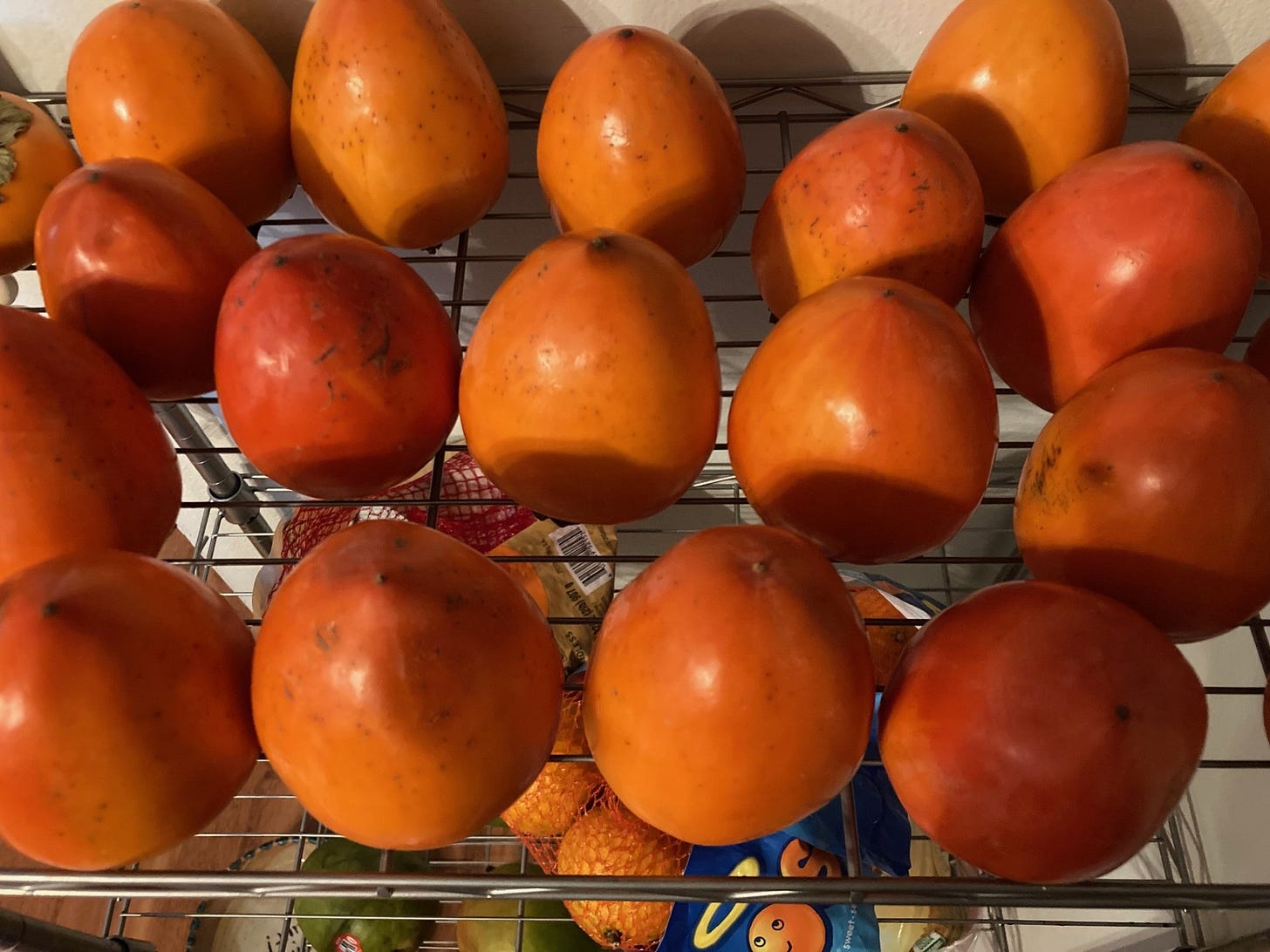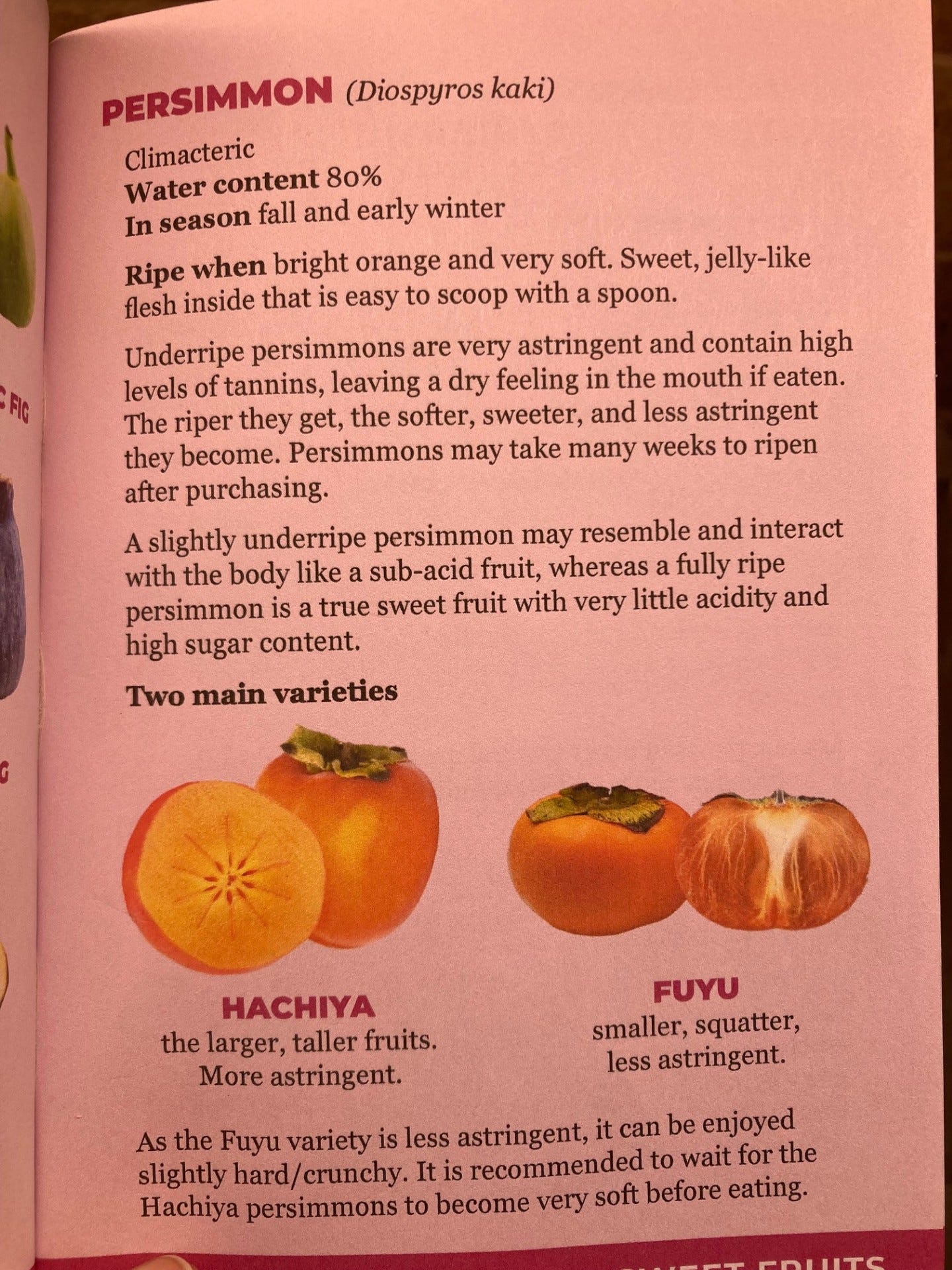I find that one beautiful way to come back to earth when the world feels extra heady and complicated is to become fully present with a simple mono-meal of fresh real fruit, and the persimmon is one of my most favorites. Every year I look forward to feasting on them in the late fall and early winter. I’m not sure that I knew anything about this delicacy before I adopted my raw vegan ways, and it seems that nearly every time I am buying them in a store somebody asks me what they are, and how to eat them. I am always so happy to share my joy in these exquisitely sweet, cheerfully orange gems of the fruit world!
The amazing persimmon is an under-appreciated fruit, and I think that may be mostly due to its relative rarity in grocery stores, and its special ripening requirements. There are quite a few varieties, but mostly what you can find in regular grocery stores will be the Asian Fuyu and Hachiya. You may find other varieties in an Asian market. Several types grow well in the eastern half of the U.S., all the way from Florida to Michigan. I have not yet grown them myself, but I was fortunate in Michigan to find a farmer a few miles down the road with orchards full of U-pick paw-paws and persimmons! His persimmons were much smaller than what you find in the stores, but equally delicious. I have a new friend in Florida who grows them - here is a picture of one of his trees just finishing its production for this season:
Astringent varieties must ripen to a very soft state to be safely edible and sweetly delicious. The Hachiya is one of these. It is an acorn-shaped, often larger variety. It will be quite soft to the touch when ready to eat, and the moistness of the inside will start to show through the almost translucent skin. It will become fragile! At this stage, I slice the top off with a sharp knife, cup the fruit in the palm of my hand, and scoop the delicious jelly-like fruit out with a spoon. The tomato-shaped Fuyu variety is non-astringent, and can be enjoyably eaten at any stage of ripening. It becomes sweeter as it softens and becomes a deeper orange color. In its harder stage, it is a bit like a honey-sweetened apple and can be peeled and diced up. As it ripens and softens further, it starts to approach the texture of the pudding-ripe Hachiya.
This is a page from a great little book called “The Fruit Companion,” by my friend Seth Bailin. You can get it here: thefruitcompanion.com .
When you buy persimmons at a store, they will usually be hard (easier to transport and display) and will ripen on your counter at home. The Hachiyas may take many days or even several weeks to ripen sufficiently, but your patience will be well rewarded! I tend to buy a lot of persimmons at once, as they will ripen gradually and at different rates. They may seem pricey, but they are such a wonderful seasonal treat that I will always save room in the budget to indulge when they come into season.
I almost always simply eat the fruit as-is (the fleshy part - best not to eat the skin or seeds), but they are a versatile fruit that can be peeled and frozen, or dehydrated, or incorporated into recipes. If you look online, you can find simple raw vegan recipes for persimmon pies, puddings, and sauces. It is a wonderful, richly colorful, fancy holiday fruit that will impress friends and family, especially since many people have never tasted it! A very simple and decorative way to serve a Fuyu persimmon is to turn it on its side and make thin slices, revealing the gorgeous star-flower formation in the center. A platter of these will be an inspirational addition to any holiday table.
I love to inspire people at holiday gatherings with the glorious simplicity and completeness of fruit, nature’s most splendid recipe meant for us! Easy to prepare, easy to digest, easy to clean up, and beautiful to behold. I love to see people delight in my simple presentations, standing out radiantly amongst all the complex cooked concoctions.
In all the complexity of today’s world, a fruit mono-meal or a simple platter of fresh seasonal fruit, reminds us in a deep primal way of our natural origins, and reconnects us immediately with our creative, beautiful divine spark. Accentuate the sacred by eating the fruit outdoors in the sunshine, or if it’s too cold light a candle and become fully present to this divine gift. It takes a special kind of intentionality to honor the most deeply real and simple things, amidst all the clatter and temptations of modern living and modern holiday celebrations.
I offer you the wonderful persimmon fruit as an inspiration to work with!





Thanks Ellen! - Yes! - I our food forest in northern California, we have a Hachiya tree and a Fuyu tree, and they are both absolutely fantastic and our favorites - especialy the Fuyu - every year (we planted it about 11 years ago) it gives us about 200 fruits, and they are SO delicious - especially when they fully ripen - we can pick them green in October, and they always ripen beautifully to orange and then soften up and we eat them in November, December, and into January and even February. This year the raccoons discovered them and ate many when still green - they are, as you say, always sweet and delicious, even when green, which makes them tempting to the raccoons, forcing us to harvest them very early, otherwise, they are all eaten by our masked bandito friends...
💕